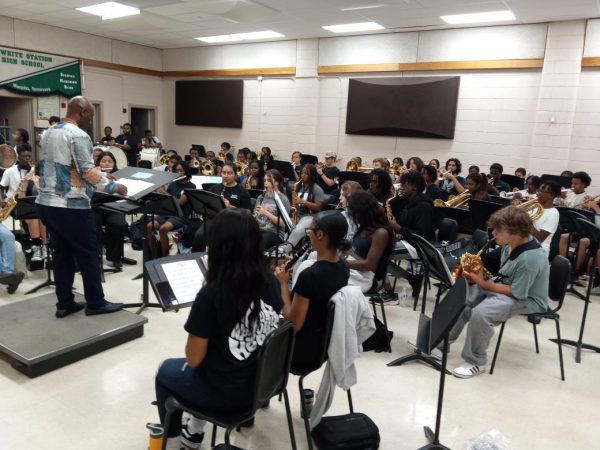White Station: A History
Albert Pike School was located on the first floor of the Albert Pike Masonic Lodge- a log cabin on the outskirts of Memphis. The school was loosely established in 1851.
Art teacher Charles Berlin started teaching at White Station in 1989, and has independently researched the beginnings of the school.
“The mere fact that [the school] was called Albert Pike High School is pretty wild and wacky,” Berlin said.
Albert Pike was a Freemason; his is the only statue of a Confederate general in Washington D.C. Freemason meetings were conducted on the second floor of the Memphis lodge, and when the group relocated the school grew to occupy both floors. In 1897 Albert Pike had eighty students, making it the largest Shelby County school in the district (SCS began in 1871).
Today, Albert Pike is known as White Station High School.
In 1850, Colonel Eppy White donated two acres of land to assist in establishing the Eudora Baptist Church. Albert Pike classes were temporarily held in the church while the lodge was torn down in 1920 and a new school was built on the remainder of Colonel White’s land, down the street from the Poplar Railroad Station. The school was renamed White Station, and the “state-of-the-art” building had two classrooms, bathrooms, an engine room, a library and coal lamps. Students walked or rode horses to school, and drew their own water in a cedar bucket. 1923 brought five-cent soup and cracker lunches, served by the Parent Teacher Association, plus new bathrooms, classrooms and a principal’s office.
By 1937, an auditorium, ninth grade class, thirty- member band and football team were added. The team mascot was a bulldog: its colors were blue and white. In the following years, a home economics lab was added.
The 1950s brought about an era of change for White Station: becoming a Memphis City School in 1950, adding elementary and junior high school divisions, developing new band and athletic departments.
Rush Siler became the first formal principal that same year. In 1953, growing student numbers called for the construction of the South Annex for the elementary school, and today’s Main Building for the high school. The East Annex was the junior high building. Nothing of the school’s previous identity remained when students voted on a new mascot and school colors; we can thank the class of ‘57 for our Spartan mascot and green and gray colors.
During this new era, the basement was a wood-working shop, Tsz-Ho Chan and Yanli Cui’s present rooms were the biology lab. George Richardson’s room has remained the chemistry lab, just as the art and home ec departments have remained on the second floor. The cafeteria seated five hundred students and doubled as an auditorium for assemblies.
“[Assemblies] should be a part of high school life, they build school moral,” deaf and hard of hearing teacher Rita Grivich said.
Grivich started teaching at White Station in 1970 when assemblies were still a regular part of White Station culture. Assemblies were held for every football game, holiday and the much-loved Queen of Clubs Pageant.
“All of the departments worked together, and the students showcased their talents,” Grivich said.
The wood-shop built the ramp, home ec students sewed the curtain and math students designed the judges’ ballots. Sadly, the Queen of Clubs Pageant has not passed the test of time.
“So much is missing with kids not being exposed to the different departments,” Grivich said. “As diverse as we are, we need to see some of that exposed on a stage.”
In the late 1960s, White Station integrated. This was the school’s first step toward the diversity that it is known for today. By about 1965, the school offered one class for deaf and hard of hearing students, but the deaf mainstream program did not start until interpreters came to the school in the late 70s or early 80s. Junior Reserve Officers’ Training Corps (JROTC) started in 1967, and the optional program was implemented in the 80s.
Latin teacher Dawn LaFon came to White Station in 1988, when Don Coffey was principal.
“He ran a tight ship, everyone did what they were supposed to do around White Station then, or you would get a yellow post-it note from Mr. Coffey asking you to come to his office,” LaFon said.
By this time, White Station was already established as a top-tier school, always having close to the largest, if not the largest, number of National Merit Scholars in the state and the middle school had moved to its current location on White Station Road. The elementary school relocated in the late 90s and the South Annex held high school classes until it was torn down to make room for the Freshman Academy in 2011.
“There was a time when this building was all but falling down around us, before the renovations. And I told people then, ‘White Station High School is a true triumph of the human spirit’,” LaFon said. “What keeps me in it is that I have absolutely wonderful colleagues who care about their students as much as I care about mine, and I have the best students in the world.”
White Station is still the largest Shelby County School, but has grown from eighty to around 2,400 students. Mr. Mansfield is the seventh principal, and we still have the most National Merit Scholars in the state every year. We have famous alumni: Kathy Bates, Joe Jackson, Andrew VanWyngarden and Cary Fowler, just to name a few. This is our school’s history and the people who have shaped it. How will you leave your mark?
Your donation will support the student journalists of White Station High School. Your contribution will allow us to purchase equipment and cover our annual website hosting costs.






































